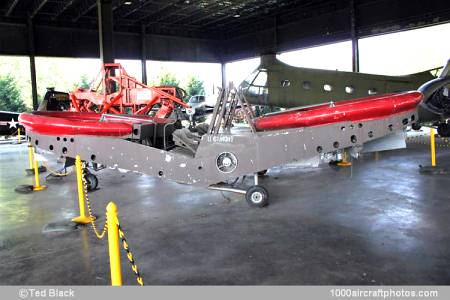07/31/2011. The Piasecki Model 59K, US Army designation VZ-8P, was a new type of vertical take off aircraft which derived its lift from two horizontal opposite-rotating rigid three-blade rotor/propellers enclosed in ducts, one at the front and one at the rear. The rotors were shielded completely on all sides, which eliminated the usual danger of unprotected rotors.
Intended for military observation, liaison and other duties, the VZ-8P was designed to fly close to the ground on normal missions, taking advantage of all natural cover. However, it is in no way dependent on ground effect and it was claimed to be capable of flying high enough to cross over most of the mountainous terrain in the United States and of flying at a forward speed of more than 150 mph (240 kmh).
To determine the efficiency of the rotor system, and the stability and control characteristics of the design, initial ground tests were made with a full-scale, full-power test unit on a strain-gauged balance rig, mounted on the bed of a large trailer truck. This work had been completed to the satisfaction of the US Army Transportation Research and Engineering Command by the spring of 1958.
The first flying prototype (s/n 58-5510) built under the US Army contract became airborne for the first time on October 12, 1958. Five months later it was demonstrated to the US Army, including an "out-of-ground-effect" flight 25 ft (7.6 m) above the ground. It its original form, the VZ-8P was powered by two 180 hp Lycoming O-360-A2A engines, driving inward to a central gearbox and so arranged that either engine could drive both rotors after failure of the other. Rotor/engine rpm ratio was 0.56 to 1. Initially named Sky-Car by Piasecki, it was later named Airgeep.
Subsequently it was re-engined with a 425 shp Turboméca Artouste IIB shaft-turbine, giving an all-round improvement in performance and payload. It flew for the first time with the new engine on June 28, 1959. The engine and seats for the pilot and three passengers are mounted between the rotor ducts. The pilot's flying controls were similar to those of a conventional helicopter and provide directional control through a series of pivoted vanes mounted under the rotor ducts. All components were housed in the low flat aluminum alloy chassis, which was fitted with a non-retractable tail wheel landing gear to provide ground maneuverability.
For evaluation in water operations and from the decks of ships, the wheel landing gear of the VZ-8P was replaced by floats in 1961, and subsequently loaned to the USN as the Model 59N Seageep. Upon its return to the Army its Artouste IIB was replaced by a lighter and more powerful 480 hp AiResearch 331-6 turbine.
The PA-59H Airgeep II was an improved five-seat version of the Model 59K Airgeep I, developed under a further contract from the US Army Transportation Research and Engineering Command. The second VZ-8P (s/n 58-5511) incorporated several significant design changes, in particular, its two three-blade ducted rotors were driven by two 530 shp Turboméca Artouste IIC (modified) shaft-turbines, giving multi-engine reliability, and it had powered wheels for self-contained ground mobility and for extended range when conditions permit driving over land.
The prototype of the PA-59H began its program of ground and flight tests in mid-1961 in stripped configuration and made its first free flight in the summer of 1962. Both VZ-8Ps are on display at the museum at Ft. Eustis,
